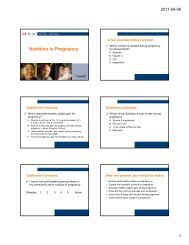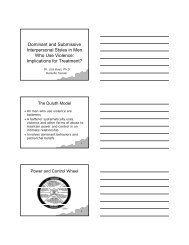Lung Hypoplasia: Prediction of the severity - Onehealth.ca
Lung Hypoplasia: Prediction of the severity - Onehealth.ca
Lung Hypoplasia: Prediction of the severity - Onehealth.ca
- No tags were found...
Create successful ePaper yourself
Turn your PDF publications into a flip-book with our unique Google optimized e-Paper software.
Anatomi<strong>ca</strong>l and FunctionalPredictors <strong>of</strong> Fetal & Neonatal<strong>Lung</strong> <strong>Hypoplasia</strong>Yuka Yamamoto, M.D.Fetal & Neonatal Cardiology ProgramUniversity <strong>of</strong> AlbertaDec. 15 th 2009
Outline• Fetal <strong>Lung</strong> Development andPhysiology• Criteria <strong>of</strong> <strong>Lung</strong> <strong>Hypoplasia</strong> (LH)• Incidence and Causes <strong>of</strong> LH• Parameters to Predict <strong>the</strong> Severity <strong>of</strong>LH• Clini<strong>ca</strong>l <strong>ca</strong>se (R.T.)• Nitr<strong>of</strong>en-induced CDH Rat Study
Outline• Fetal <strong>Lung</strong> Development andPhysiology• Criteria <strong>of</strong> <strong>Lung</strong> <strong>Hypoplasia</strong> (LH)• Incidence and Causes <strong>of</strong> LH• Parameters to Predict <strong>the</strong> Severity <strong>of</strong>LH• Clini<strong>ca</strong>l <strong>ca</strong>se (R.T.)• Nitr<strong>of</strong>en-induced CDH Rat Study
Development <strong>of</strong> <strong>the</strong> Human<strong>Lung</strong>Type II pneumocytesInitial differentiationComplete matureCrests protrude into sacculesForm <strong>the</strong> acinus1986 Pringle KC
Factors for Fetal <strong>Lung</strong>Development‣<strong>Lung</strong> growth• Amniotic fluid volume• Intrathoracic space• <strong>Lung</strong> liquid volume• Pressure• Breathing movements‣<strong>Lung</strong> maturation• Glucocorticoids• Thyroid hormones
Outline• Fetal <strong>Lung</strong> Development andPhysiology• Criteria <strong>of</strong> <strong>Lung</strong> <strong>Hypoplasia</strong> (LH)• Incidence and Causes <strong>of</strong> LH• Parameters to Predict <strong>the</strong> Severity <strong>of</strong>LH• Case Report• Nitr<strong>of</strong>en-induced CDH Rat Study
<strong>Lung</strong> <strong>Hypoplasia</strong> (LH):Clini<strong>ca</strong>l Features‣Immediate onset <strong>of</strong> severe respiratoryinsufficiency after birth‣Small lung <strong>ca</strong>pacity‣Required high ventilatory pressures in <strong>the</strong>absence <strong>of</strong> airway obstruction oratelectasis
Pathologi<strong>ca</strong>l Criteria <strong>of</strong> LH< 28 weeks<strong>Lung</strong> / Body weight 28 weeks<strong>Lung</strong> / Body weight
Outline• Fetal <strong>Lung</strong> Development andPhysiology• Criteria <strong>of</strong> <strong>Lung</strong> <strong>Hypoplasia</strong> (LH)• Incidence and Causes <strong>of</strong> LH• Parameters to Predict <strong>the</strong> Severity <strong>of</strong>LH• Clini<strong>ca</strong>l <strong>ca</strong>se (R.T.)• Nitr<strong>of</strong>en-induced CDH Rat Study
2.7 in 10,000 live birth; 2007 D. Gallot et al.LH: Incidence‣9-11/ 10,000 live births‣Perinatal mortality: 70% (55- 100%)• Preterm Premature Rupture <strong>of</strong> Membranes(pPROM) : 10% <strong>of</strong> all pregnancies (5-45% withworld-wide reports)90%in labour10%prolonged pPROMLH 12.9% in pPROM(15- 28w); 2000 HungWinn.• Congenital Diaphragmatic Hernia (CDH):
LH: Etiology•Oligohydraminos based•Renal: bilateral renal agenesis•Non- renal: pPROM•Intrathoracic masses (CDH, Congenital CysticAdenomatoid Malformation; CCAM)•Renal oligohydraminos•Skeletal malformation•Neuromuscular and central nervous system anomalies•Pleural effusions•Cardiac lesions•Abdominal wall defects•Primary LH syndromes associated with LH2000 J. Laudy and J. Wladimir<strong>of</strong>f
Preterm Premature Rupture <strong>of</strong>Membranes (pPROM)Perinatal mortality in pregnancies with pPROMAFI1cm2cm5cm10cmPeriod 14 daysLatency period14 days7 days0 days28 days21 days•Gestational age at rupture <strong>of</strong> membranes•Latency period•Volume <strong>of</strong> amniotic fluid2000 H. Winn et al.Independent factorsto predict LH
Congenital Diaphragmatic Hernia(CDH)
Outline• Fetal <strong>Lung</strong> Development andPhysiology• Criteria <strong>of</strong> <strong>Lung</strong> <strong>Hypoplasia</strong> (LH)• Incidence and Causes <strong>of</strong> LH• Parameters to Predict <strong>the</strong> Severity <strong>of</strong>LH• Clini<strong>ca</strong>l <strong>ca</strong>se (R.T.)• Nitr<strong>of</strong>en-induced CDH Rat Study
Parameters to Predict Severity <strong>of</strong>LH• <strong>Lung</strong> Volume Estimation• Branch Pulmonary Artery (PA) Diameters• PA Doppler Flow:– Acceleration Time/ Ejection Time (AT/ET ratio)– Peak Early Diastolic Reverse Flow (PEDRF)– Pulsatility Index (PI)• 3D <strong>Lung</strong> Volume Measurement (echo)• MRI:– <strong>Lung</strong>-to-Liver Signal Intensity Ratio (LLSIR)– <strong>Lung</strong> volume
2D <strong>Lung</strong> Volume Estimation•TA/ HA (thoracic / heart area) ratio•TC/ AC (thoracic/abdominal circumference) ratio•CC/ TC (<strong>ca</strong>rdiac/ thoracic circumference) ratio•(TA- HA)/ TA ratioBoth <strong>the</strong> ellipse and diametermethods <strong>of</strong> measuring<strong>ca</strong>rdiothoracic ratio arereproducible.2006 A. Awadh et al.
Observed/ Expected <strong>Lung</strong> area toHead circumference (O/E LHR)survivalsdied1996 A. Metkus, et al.Sensitivity 46%, False positive rate 10%2007 J. Jani et al.
3D <strong>Lung</strong> Volume Measurements*Without LHWith LH*Without LHWith LHSensitivity: 83%, Specificity: 100%PPV 100% NPV 92%2007 F. Gerards et al.
Pulmonary ArteryHEARTLUNG
Pulmonary Artery
Pulmonary ArteryGood correlationwith lung weight!2002 J. Sokol et al.
PA Diameters in CDHRt. CDH2001 J. Sokol et al.Ipsilateral branch PA diameter results inprogressive hypoplasia advanced gestation.
Duration onoxygenDuration <strong>of</strong>ventilationLength <strong>of</strong>stayr p r p r pLPA(ga) - 0.69 0.009* -0.68 0.007* -0.77 0.002*RPA(ga) -0.43 0.139 -0.41 0.143 -0.41 0.1602006 Sokol et al.Ipsilateral PA Diameter predictive <strong>of</strong>respiratory morbidity
Branch PA Doppler FlowPeak Systolic Velocity(PSV)Peak Diastolic Velocity(PDV)Peak Early Diastolic Reverse Flow(PEDRF)Pulsatility Index (PI) = (PSV- PDV)/ Mean Velocity
Branch PA Doppler FlowProximalDistalMiddle2000 & 2002 J. Laudy
PA Doppler Depending on <strong>the</strong>Middle branchPartDistal branch2000 J. LaudyThere are Inter-pulmonary (proximal, middle, distal)differences in arterial blood flow velocity parameters
Acceleration time / Ejection time (AT/ET) ratioATETIn pulmonary hypertension•Rapid acceleration•Short acceleration timeAT in adults highly correlates with mean pulmonaryartery pressure.1983 Circulation, A. Kitabatake et al.
AT/ET ratio by Fuku et al. 2003 Am J OnstetGynecol.Normal range <strong>of</strong> LPA (n= 75)Outcome <strong>of</strong> suspected LH (n=17)Dead <strong>ca</strong>sesSurvived <strong>ca</strong>sesAT/ ET ratio correlates with survival in fetusesat risk for lung hypoplasia
Peak Early Diastolic Reverse Flow (PEDRF)PEDRFHigher PEDRF is seen with higher pulmonary vascular resistance.
Peak early diastolic reverse flow (PEDRF)By O. Moreno- Alvarez et al. 2008 Ultrasound Obstet GynecolPEDRFContralateralIpsilateralcontrolscontralateralipsilateralPEDRF has signifi<strong>ca</strong>ntrelationship with O/E LHR
Maternal Hyperoxygenation TestBeforeReactive: Decrease in Pulsatility Index (PI) > 20%AfterNon reactive: Decrease in PI < 20%BeforeAfter2002 R. Broth et al.
Maternal Hyperoxygenation Testn= 29Non- Reactiven= 15Reactiven= 14Lethal LH (+)n= 12Lethal LH (-)n= 3Lethal LH (+)n= 1Lethal LH (-)n= 13Sensitivity: 92%, Specificity: 82%2002 R. Broth et al.
Maternal Hyperoxygenation Test1998 Circulation, J. Rasanen20- 26 weeksRoom air60% oxygenBefore During AfterBefore During After31- 36 weeksRoom air60% oxygenBefore During AfterBefore During After
Fetal <strong>Lung</strong>-to- Liver Signal IntensityRatio (LLSIR) at MRI<strong>Lung</strong>Liver2005 L. Brewerton et al.
LLSIR by L. Brewerton et al. 2005Hypoplastic lungsAt more than 25weeks, all LLSIRs for<strong>the</strong> LH are outside <strong>the</strong>lower bound.LLSIR is high potential predictor<strong>of</strong> severe LHafter 25 weeks <strong>of</strong> gestation.
Outline• Fetal lung development andphysiology• Criteria <strong>of</strong> <strong>Lung</strong> <strong>Hypoplasia</strong> (LH)•LH <strong>ca</strong>uses• Parameters to predict <strong>the</strong> <strong>severity</strong> <strong>of</strong>LH• Clini<strong>ca</strong>l <strong>ca</strong>se• Nitr<strong>of</strong>en-induced CDH rat study
Clini<strong>ca</strong>l <strong>ca</strong>se• 37 y.o. G3 P1• Medi<strong>ca</strong>l history: asthma• Obstetrics history: ectopic pregnancy• Family history: N/A• Natural pregnancy• 21 weeks: pPROM with no sign <strong>of</strong>chorioamnionitis• Antenatal steroids at 24 weeks• Antibiotics: amoxicillin, erythromycin
pPROM at 31 weeks
pPROM at 33 weeksBranch PA DiametersRPA= 0.43 cmLPA= 0.44 cm
Room AirRPALPAHyperoxygenantionAT/ET= 0.18PEDRF= 14cm/sAT/ET= 0.15PEDRF= 18cm/sPI= 3.7RPALPAAT/ET= 0.13PEDRF= 11cm/sPI= 2.17AT/ET= 0.15PEDRF= 14cm/sPI= 2.5PI= 34% reduction
Clini<strong>ca</strong>l Report: Outcome• 34w2d• C/S due to <strong>the</strong> risk <strong>of</strong> chorioamnionitis• 2010g, 44.5cm boy• Apgar scores 3/6, UA pH= 7.28• Brief ventilatory support with CPAP• No positive results from infection screening• Discharge: 4 days later.Good lung maturity !
Outline• Fetal <strong>Lung</strong> Development andPhysiology• Criteria <strong>of</strong> <strong>Lung</strong> <strong>Hypoplasia</strong> (LH)• Incidence and Causes <strong>of</strong> LH• Parameters to Predict <strong>the</strong> Severity <strong>of</strong>LH• Clini<strong>ca</strong>l <strong>ca</strong>se (R.T.)• Nitr<strong>of</strong>en-induced CDH Rat Study
Nitr<strong>of</strong>en –induced CDH Animal ModelSprague- Dawley ratE 9.5 day Control 100mg Nitr<strong>of</strong>enE 11.5- 20.5 day ControlSildenafil(100mg/kg/d)ControlSildenafil(100mg/kg/d)20.5 day:Echo examination (fetal PAs) & Hyperoxygenation testC/SEvaluation <strong>of</strong> lung morphologyUp to 50%
ControlRoom airHyperoxia
Upcoming Research in• Prospective study• 130 patientsEdmonton– 60 lung hypoplasia (CDH, pPROM, CCAM,renal agenesis)– 70 control• Investigate <strong>the</strong> best predictor <strong>of</strong> lunghypoplasia <strong>severity</strong> using echo imaging,maternal hyperoxia testing and fetal MRIassessment
Thank you very much!For great supportDr. Lisa HornbergerDr. Lisa HowleyDr. Bernard ThebaudDr. Venu JainDr. Chari RadhaDr. Ravi BhargavaResearch Nurse: WinnieSavardFounding: Juntendo University
2002 J. Laudy et al. 2005 S. Yoshimura et al.<strong>Lung</strong> volume estimationTA/HA ratio(TA-HA)/TA ratiopPROMLHpPROMLHCC/TC ratioTC/AC ratiopPROMLHpPROMLH
1996 A. Metkus et al.55 fetuses with CDHdiagnosed<strong>Lung</strong> area to Headcircumference (LHR)
<strong>Lung</strong> area to Headcircumference (LHR)2006 J. Jani et al.
<strong>Lung</strong> area to Headcircumference (LHR)184 CDH <strong>ca</strong>ses between 22 to 28 weeks2006 J. Jani et al.Poor prognosis= LHR< 1.0 with liver herniation
Observed LHR/ ExpectedNormal fetusLHR (O/E LHR)2005 C. F. A. Peralta et al., 2007 J. Jani et al.
LHR & O/E LHR in CDHSensitivity 46%, False positive rate 10%2007 J. Jani et al
PA Diameters in Normal FetusLPARPA2007 S. Katayama
PA diameters in CDH2008 R. Ruano et al.PA diameter may be useful topredict perinatal death but not LH itself.
NonreactiveeactiveSensitivity: 92%Specificity: 82%PPV: 79%NPV 93%2002 R. Broth et al.
MRI (LLSIR) at 29 weeksRtCoronal<strong>Lung</strong>LiverLt<strong>Lung</strong>HeartLLSIR=
















